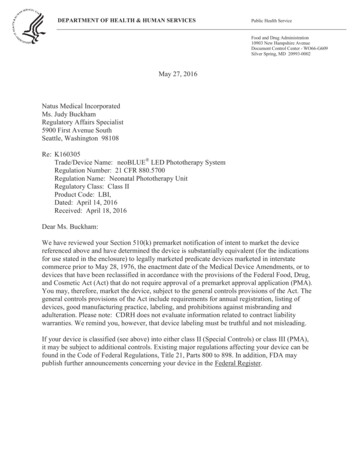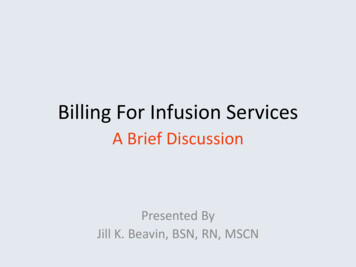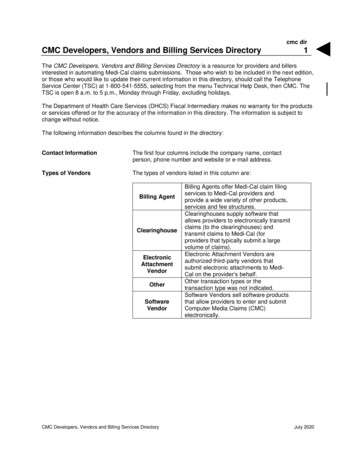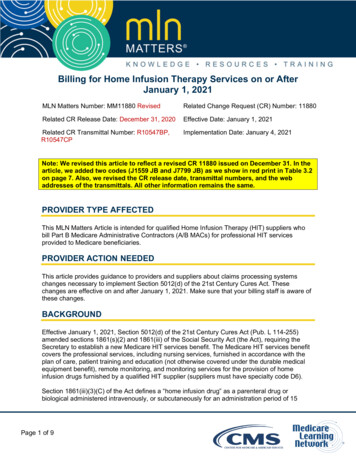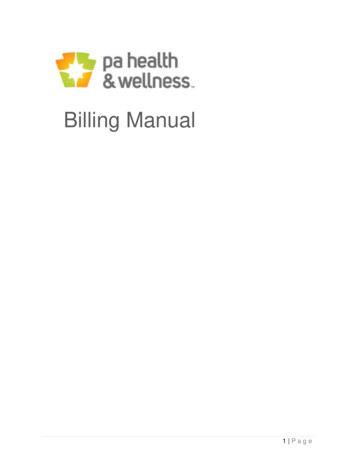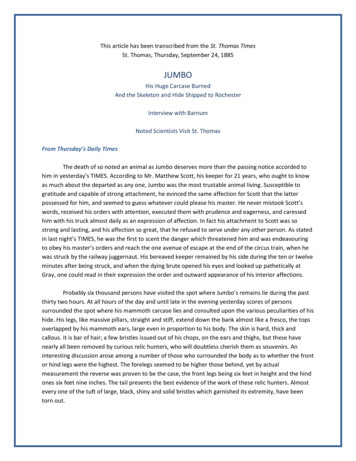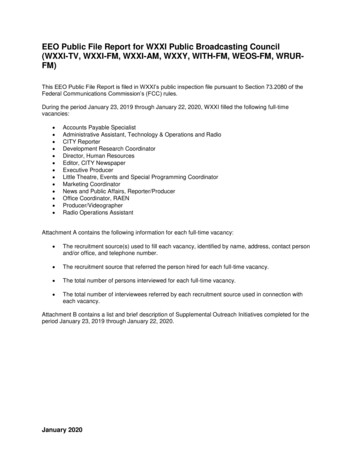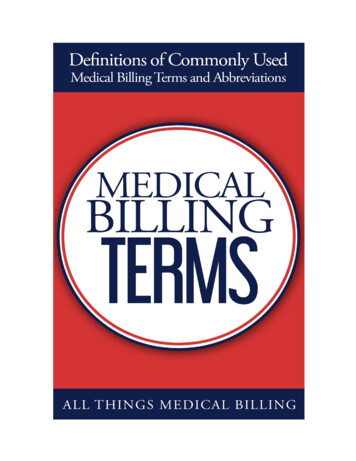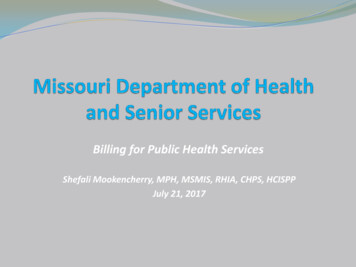
Transcription
Billing for Public Health ServicesShefali Mookencherry, MPH, MSMIS, RHIA, CHPS, HCISPPJuly 21, 2017
Assumptions Certain information in this presentation comes from avariety of sources such as: CMS (their website cms.gov) AHIMA, AAPC, Billing Companies, and STD-TAC Various Public Health Agencies, Payers andClearinghouses Industry blogs, journals, etc.Disclaimer: The materials for this course are for informational purposes only. Information on this topic does not constitutelegal or business advice. Information in this course is provided without warranty of any kind, either expressed or implied,including but not limited to, the implied warrantees of fitness for a particular purpose. Many policies, procedures, andcodes will vary based on individual departments, services offered, and individual situations. Specific coding and payerguidelines should be reviewed prior to the submission of claims for reimbursement. Use of this material does not guaranteethat claims have been formatted or submitted properly or that claims will be reimbursed as billing/coding requirements andinsurance policies and coverage may change from time-to-time. It is the responsibility of every local health agency andagency to verify information as it pertains to their own individual agency or agency.2
Objectives Understand why local public health agencies (LPHAs)should bill for public health services. Develop a general understanding of: The billing process and guidelines for public healthservices. How to bill Medicaid and Medicare for public healthservices provided through LPHAs. How a clearinghouse fits in with billing and claimsprocessing. How to minimize denials through improved coding forservices provided through LPHAs. Questions and Answers3
Why bill for Public Health Services? Billing for public health services of insured individualsmakes sense as a way to save money for federal, state, andlocal governments, assure proper stewardship of public fundsand promote public and private payer participation infinancing Missouri’s public health programs. The 2010 Patient Protection and Affordable Care Act(PPACA) has increased the proportion of the populationwith insurance coverage for immunizations, strengtheningthe rationale for LPHA billing operations.4
Why bill for Public Health Services? The costs of immunizing children and adults can place aburden on the scarce resources of LPHAs. State funding isprovided in the form of Immunization Action Plan grantsand State Aid for local public health activities. Ensure that compliance with state and federal programs suchas the Vaccines for Children program and public third partypayer requirements are maintained.5
Delivery Models Local public health agency. Local public health agency partnering withcommunity based organization(s) or individualphysicians and other clinicians. Local public health agency partnering withlaboratories.Note: Some payers may categorize local public healthagency clinics as “Rural health clinics”.6
Services Screening/Evaluation Testing Diagnosis Monitoring Counseling Treatment7
Providers Physician Nurse practitioner Physician assistant Peer counselors certified as Community HealthWorkers Community based organizations Laboratories8
Foundations for Successful Billing- 3Components Information System Capacity: LPHAs need an information system or service that canprovide: Single-point patient data entry Useful for multiple clinical service areas within an LPHA Efficient data transmission Electronic claim submission Availability of service data for billing functions Account reconciliation Financial and statistical reporting capabilities Data import and export capabilities9
Foundations for Successful Billing- 3Components Third party relationships: To obtain reimbursement for services provided to enrolledpatients, LPHAs need to develop relationships with insuranceplans, including: Network agreements with insurance plans. Credentialing of LPHA practitioners with insurance plansso that LPHAs can be reimbursed as network providers. Clearinghouse agreements to enable streamlined LPHAcommunication with payers. These services may be free orrequire contract agreements.10
Foundations for Successful Billing- 3Components Workforce Capacity and Capability: LPHAs need sufficient personnel resources to: Handle scheduling and registration.Submit claims, post payments and address outstandingaccounts.Handle electronic claims, enrollment process and submitpaperwork for electronic funds transfer (EFT) deposits frompayers.Manage the health plan contracting and credentialingeffort.Handle IT support for software implementation,maintenance and troubleshooting.11
Understand Billable and Non-billable Service Types12
Identifiers Needed for Billing Taxonomy codes Tax Payer identification number Provider National Identifier number (NPI)13
Taxonomy Codes In the medical billing and payment world, “provider taxonomy”refers to the national provider classification system defined by theCenters for Medicare and Medicaid Services (CMS). This national classification system was defined as part of theNational Provider Identification (NPI) rule of the Health InsurancePortability and Accountability Act (HIPAA). The national provider taxonomy codes identify a provider’s typeand area of specialization. Taxonomy codes are 10 characters in length and include both lettersand numerals. The first two digits are provider type, the next twodigits are provider specialty, and the next five digits are providersubspecialty. The last character is reserved for future use so it willdisplay as an “X.”14
Tax Identification Tax ID EIN (Employer Identification Number) Do you use the county’s EIN or do you have your own? If you need a copy, request 147 C from IRS. If new Tax ID is required per your organizationbusiness structure, use IRS form SS-4 to apply.15
National Provider Identifier (NPI) 10 digitshttps://nppes.cms.hhs.govIndividual Type 1Organizational Type 2If you wish to enroll as a group/org, you will need a type 2 NPIprior to applying (varying turnaround) Issued once; never expires or changes NPI registry (NPPES) accuracy is IMPORTANT-- SS#, DOB,Name spelling Systems talk to each other (SS PECOS MCS) Taxonomy chosen when you first get an NPI number, i.e.:specialty driven Mass Immunizer 251K00000x (public healthonly)16
National Provider Identifier (NPI) Every provider enrolling with an NPI number must have anNPI “base location” which is identified by three addressesthe: Physical location Mailing address Pay-to address The NPI base location is used to anchor all of the provider’sNPI-related specializations and related details. In situations where an LPHA utilizes multiple locations, eachadditional office or clinic is referred to as a NPI “servicinglocation” and referenced by two addresses: the location andmailing addresses.17
Billable Service Types Could Be Evaluation and Management Services Risk assessment counseling Information and pamphlets HIV/STD counseling and testing Linkage to Care & Patient Navigation/ CareCoordination/ Case Management Oral health Screening and treatment for: HIV/AIDS/STDs18
Non-billable Service Types Case management codes are not recognized byMedicare but other insurers may cover them, so it isimportant to check with the individual insurers. Ryan White Funded Support Service19
Understand Documentation Needed for Billing20
Collect Billing Information Different sources Providers Clients Insurers Medicaid/Medicare From Clients/Insurers Member number/Group number Plan address Beneficiary/Subscriber number Client’s social security number (may be optional) From Providers Procedure and diagnosis information (CPT and ICD codes)21
Understand Documentation Needed inOrder to Bill Documentation within the health record must clearlysupport the procedures, services, and supplies coded. Accuracy, completeness, and timely documentation areessential, and LPHAs should have a policy that outlinesthese details. All services provided should be indicated on theEncounter Form/Superbill whether reportable orbillable. Encounter forms should reflect the individual staffmember’s identification number assigned by the healthagency’s billing system.22
Documentation Needed Documents might include: The State Medicaid MCO model contract The RFP summarizing the MCO’s contractual obligationsand the terms to be passed to providers Draft contract between the MCO and your local publichealth agency/clinic and/or Community Basedorganization/provider Exhibits Referenced documents23
Documentation Needed Documents might include: Agency Certifications and Licensure – W-9, LiabilityInsurance, CLIA Certificate Provider Numbers – LPHA NPI number, Medicaid orMedicare numbers Documentation – charting of services Coding – list of services and established fees you provide Verification of Client Eligibility – knowing what theclient is eligible for prior to providing service Electronic Payment Management System – billingsystem able to receive electronic checks from providers24
Policies LPHAs should have the following policies written and educate staffon: List name of designated individual who will do the contracting,authorized signer, and that person’s back up. Confidentiality statement for person who is doing thecontracting. (Have person sign it for compliance with HIPAA). List of services provided by local health agency clinic. List of contracted payers and provisions for services. List of community based organizations and contact information. Key billing steps should be written and updated as changesare necessary or occur.25
Review Contract Terms Review terms for: Balance Billing - occurs when the LPHA bills the clientfor the difference between what they charge and thehealth insurance allowable amount. Some contracts between insurers and LPHAs do notallow providers to balance bill. A provider who"Accepts Assignment" agrees not to balance billpatients.26
Review Contract Terms (continued) Review terms for: Fee-for-Service insurance - seldom pays 100% of whatproviders charge. The "Allowable Amount" is the price that aninsurance company will pay for a specific service. This amount is based on a negotiated "FeeSchedule." Sometimes it is based on the "Usual andCustomary Charge" for providers in a givengeographic area.27
Fee Structures Fee schedules Fees and private insurance Standard fees for payers Medicare Medicaid Private insurance Self pay Payment policies Sliding scale Time of service/Cash discount28
LPHA Service Charges The first “rule” to consider is that “your charge is yourcharge.” For example, the LPHA may not vary their charge by payorsource but may accept a variety of reimbursements as fullpayment for that service. (e.g. The LPHA might have a charge of 100 for a service,but accept as full payment: 92 from Medicaid; 85 froma particular industry in your community with whom youhave negotiated a discounted rate; and 0, 20, 40, 60, 80 or 100 from self-pays, depending on where they fallon the sliding fee scale.)29
LPHA Service Charges Situations may exist where the LPHA must bill visits toMedicaid one way and private insurance (3rd partypayors) a different way. Examples include: STD & TB (LPHA bills a T1002 toMedicaid while billing a 99211 to private insurancesince private insurers do not recognize the T codes).30
Payment Terms Claims submission Clean claims Payment methods Payment amount Payment timing Under and over payments Recoupment Dispute resolution31
Superbills, Charge Tickets, and EncounterForms Communication tool between clinician and biller describing what occurred during the encounterElectronic or paper – includes Diagnosis, CPT, modifiersBe careful with EHR templates and pre-assigned codesIs it up-to-date and reflective of all services provided?Can clinicians sequence and note co-equal diagnosis codes?Can modifiers be noted?Reminder - Only the person providing the services shouldcomplete the superbill32
Superbills, Charge Tickets, and Encounter Forms33
Billing Codes CPT E/M Procedure Modifiers ICD-10 Diagnosis HCPCS34
Nurse Visits 99211 may be billed for certain services provided by a Nurse.Not all payers recognize this service.Patient must be established.Provider-patient encounter must be face-to-face.An E/M service must be provided. Generally, this means that the patient’s history isreviewed, a limited physical assessment is performed orsome degree of decision making occurs.35
Nurse Visits Since 99211 is an E/M code, there are some minimaldocumentation requirements in order to meet medicalnecessity for use of the code There must be a face to face encounter Nature of the presenting problem with a diagnosis from prior visit with a clinicianBrief history of the problemDocumentation of vital signs (sole reason for visitshould not be Blood Pressure check or Blood Draw)Plan of careDate/signature of the nurse or other provider36
Services Not Billed Under 99211 Administering routine medications by physician or staffwhether or not an injection or infusion code is submittedseparately on the claim Checking blood pressure when the information obtaineddoes not lead to management of a condition or illness Drawing blood for laboratory analysis or for a completeblood count panel, or when performing other diagnostictests whether or not a claim for the venipuncture or otherdiagnostic study test is submitted separately Faxing medical records37
Services Not Billed Under 99211 Making telephone calls to patients to report lab results and reschedule patient proceduresPerforming diagnostic or therapeutic procedures (especiallywhen the procedure is otherwise usually not covered/notreimbursed, or payment is bundled with reimbursement foranother service) whether or not the procedure code issubmitted on the claim separatelyRecording lab results in medical recordsReporting vaccinesWriting prescriptions (new or refill) when no otherevaluation and management is needed or performed38
Understand Key Steps Needed for Billing39
Billing Cycle40
Billing Revenue Cycle41
Billing Methods Billing Vendor Outsourced billing services Billing Staff Clinic staff bills to payer Clearinghouse used by Clinic staff to bill42
Bill SubmissionPaper CMS1500Electronic FileTransfer (EFT)Direct DataEntry (DDE) Mail Fax Email File saved to computer File is uploaded by other program(s) Data entered on insurance website Logon to web based system43
Remittance Methods Paper Mail Email (payment may come separately from remittance) Electronic Sent directly to bank account through EFT Clearinghouse Payer makes on-line viewing and downloading of paymentand/or remittance Auto-remit Mail EFT44
Billing Requirements and Processes Distinguish between public health and private health policiesand become familiar with minimum billing requirements. Assess your technical billing capabilities to identify the billingprocess that best fits your needs (i.e. use of paper claimsversus electronic claims transactions; in house billing versusoutsourcing to a clearinghouse or medical billing company). Learn what insurers want. There are a variety of ways to billand products that span from large billing and providermanagement systems to simple word processing and email. Ensure information is exchanged in a secure fashion.45
Billing Requirements and Processes Identify the services you provide and the ones you want to billfor. Understand what processes are already in place. You may already bill Medicaid, Medicare and your clients so youmight not need to make that many changes. Identify processes, policies and resources needed to beginbilling. Once you know what your processes are, you can identify whatchanges are needed to begin billing. Changes to processes are usually led or followed by changes topolicies and resources.46
Billing for Public Health ServicesNote: Payer requirements may influence selection of diagnosis andprocedure codes. Please refer to payer agreements for specifics.47
Billing for Immunizations Based on services rendered, LPHA should select applicablediagnosis and/or procedure(s):48
Billing for STDs/HIV Based on services rendered, LPHA should select applicablediagnoses and/or procedure(s):49
Billing for Laboratory Services Based on services rendered, LPHA should select applicable diagnoses and/orprocedure(s):50
Billing for Nursing Services Based on services rendered, LPHA should select applicable diagnosis and/orprocedure(s):51
Billing for Flu Shots Based on services rendered, LPHA should select applicable diagnosis and/orprocedure(s):52
Does the Biller Know Payment Rates: Can I get a list of the FFS payments by Evaluation andManagement (E&M) code for office visits? Are enhanced payments available for care coordination?How do we apply for those enhanced payments? What is the plan’s policy for timely payment? What is your plan’s rate of denied claims for primary carevisits? For infectious disease visits?53
Does the Biller Know Access to Providers/Specialty Care: As an infectious diseases provider [or HIV primary careprovider] – are referrals required for patients with HIV tosee me? Can specialists serve as primary care providers for theirpatients? Does the insurer recognize HIV as a specialty orsubspecialty? What is the plan’s credentialing requirements for primarycare providers, infectious disease specialists, nursepractitioners, physician assistants [or other clinicians inyour practice]?54
Does the Biller Know Access to Providers/Specialty Care: What access standards must the provider address? For example, does the insurer have requirements regardinghours and days of operation, coverage during evening andweekend business hours, after-hour and on-call coveragewhen a designated provider is unavailable, maximum waitingtime for an appointment, required intervals for providingspecific services, and maximum waiting-room times? For private plans in the Marketplace: I receive RyanWhite funding and am considered an EssentialCommunity Provider (ECP). What is the process forcontracting as an ECP?55
Does the Biller Know Coverage and Benefits: Who determines medical necessity? Where are thecriteria posted? What is the process for reconsideration of adetermination that a service is not a medicalnecessity? Is an infectious diseases physician on the committeethat makes formulary decisions? Is prior authorization required?56
Does the Biller Know Coverage and Benefits: What is the plan’s policy for covering CD4 count tests, viralload tests and genotype and phenotype resistance tests? Does your plan cover testing? If so, is there a restriction onthe number of tests that may be covered per year? Are disease managers or case managers routinely assignedby your plan to patients with HIV? What is their role incoordinating care? What are their clinical trainingrequirements and expertise? What utilization management and review procedures doesthe insurer employ?57
Other Considerations Is payment based on discount of full charges or fee-for service?How much revenue will this insurance company create forthe LPHA?What is the claim submission and reimbursementschedule?Are billing requirements and covered services clearlydefined? (Balance Billing)Is client insurance coverage eligibility and verification easyto acquire?What is your staff capacity to manage the billing process?58
Medicare and Medicaid Billing Guidelines and Process forPublic Health Services59
Medicaid/Medicare Billing Terminology Crossover: A claim billed to Medicaid for the Medicaredeductible and/or coinsurance is called a crossoverclaim. T
AHIMA, AAPC, Billing Companies, and STD-TAC Various Public Health Agencies, Payers and Clearinghouses Industry blogs, journals, etc. Disclaimer: The materials for this course are for informational purposes only. Information on this topic does not constitute legal or business advice.

